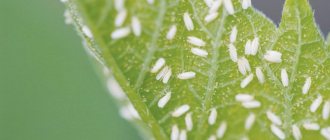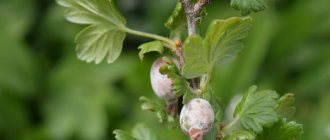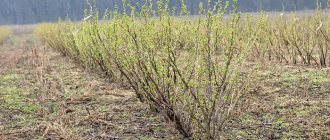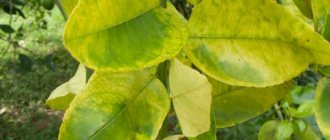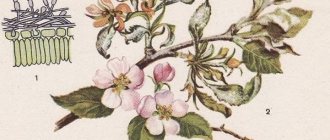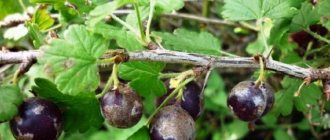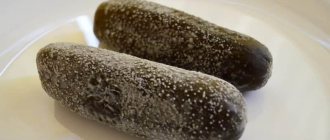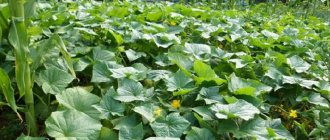Mint diseases and methods of combating them
It wouldn’t hurt for any summer resident to know the symptoms of mint diseases. Then there will be no problems with its cultivation and harvesting. In winter, you can brew fragrant tea with mint and prepare healing decoctions and infusions from it.
Rust
Rust on mint is recognized by the orange pads that appear on the back of the leaf. Gradually they turn brown, and the fungal infection spreads to the stems. The plant loses its commercial value and cannot be used for drying.
Fungal spores can be found in soil, plant debris, and airborne. Factors that provoke infection:
- decrease in air temperature;
- increased humidity (air, soil).
The fight against rust comes down to taking preventive measures. The soil and young seedlings are treated with a fungicide solution in the spring. Control the level of nitrogen in the soil; its excess weakens the plant’s immunity and increases the risk of fungal infection. Sick plants are destroyed. For cultivation, mint varieties that are resistant to rust are selected.
Powdery mildew
The most common fungal disease of mint. In the initial stage, a light white coating forms on the leaves, the appearance and structure of which resembles a cobweb. Adult plants are usually affected. Symptoms appear in August after the first cold nights.
Morning dew and prolonged rains are weather factors that lead to powdery mildew on mint. Over time, small black formations form on the leaves of the plant. These are fruiting bodies filled with spores.
Sick bushes are treated with fungicides (Topaz, Jet), but the leaves are unfit for consumption for two weeks after treatment. You can fight powdery mildew with a solution of colloidal sulfur. For prevention, in early August the bushes should be sprayed with a solution of milk (1:1) with iodine (2 drops per liter).
But it is better to support the immune system with HB 101. This herbal preparation is not dangerous to human health. In the fall, the ridge should be dug up and treated with a solution of “Fitosporin” or another insecticide.
Fusarium wilt
The causes of the disease are poor care and difficult weather conditions. Poor care means infrequent watering, leading to regular drying out of the soil. The disease can be provoked equally by hot, dry weather and cold, rainy weather.
See also
Medicinal properties and contraindications of field mint, description and care
Read
Sick plants are stunted in growth, the stems lose their elasticity, and darken in the lower (root) part. The infection (fungus) persists in the roots, stems of undisposed plants and in the soil. Sick mint bushes dry out in hot weather and rot in cold weather.
The plant affected by fusarium needs to be pulled out with a clod of earth and destroyed. To prevent infection from appearing, you need to follow simple rules:
- remove weeds from the ridge;
- Once a season, water the soil with a pink solution of potassium permanganate;
- do not add fresh organic matter to the soil;
- normalize soil acidity;
- Apply phosphorus-potassium fertilizers to the soil in spring or autumn.
Phyllosticosis
The fungus is the causative agent of phyllostictosis and begins to multiply when hot weather sets in (25-28 °C ). Its spores remain viable for a long time and overwinter in the soil on plant debris.
Symptoms of the disease:
- at the beginning there are small spots, white with a brown border;
- in the development stage - black dots in the central part of the leaf blade;
- at the completion stage, the plant sheds the leaves affected by the fungus.
Anthracnose
This disease on mint is quite rare; it most often affects plants grown by seedlings. When the mint is severely damaged, the stems become thin and bent, and all the leaves fall off. At the initial stage, anthracnose is brown spots in the central part of the leaf blade.
This disease does not occur every year and causes little damage. To combat it, simple preventive measures are enough:
- removal, destruction of an infected bush;
- soil treatment with fungicide;
- keeping the ridge clean.
Ascochyta blight
Brown spots on the stem and leaves are the first symptoms of ascochyta blight. The spots are small in size and tend to merge. Weak plants are noticeably stunted in growth, young shoots are twisted, leaves dry out and fall off.
Infection with Ascochyta leonuri Ell. et Dearn are spores that ripen in pycnidia located on the leaves of mint itself and weeds growing nearby. Catnip and motherwort often become carriers of the fungus. They need to be removed from garden beds.
Septoria
The disease is caused by spores of the fungus Septoria menthae Oudem. Mint bushes growing in high humidity conditions are more likely to suffer. The optimal temperature for the propagation of the fungus is 22-27 °C. Spots on the leaves appear in early summer.
They have a round or angular shape. The center of the spots is light, the border is dark, almost black. After some time, black dots (pycnidia) appear on the surface of the affected leaves, and tissue destruction occurs.
Downy mildew
Peronosporosis affects the leaves and inflorescences of mint. The disease is caused by the fungus Peronospora stigmaticola Reunk; its spores persist on plant debris in the soil. Ideal conditions for the formation of conidia: high humidity, moderate temperature.
Symptoms of peronosporosis:
- a loose coating of gray-violet hue on the flowers;
- shapeless spots of light green color on the back of the leaves;
- the spots are covered with a coating of spores;
- with severe damage, the leaves lose their shape, crumble, the inflorescences turn brown, dry out or rot.
See also
General information about pennyroyal, planting and care of ombalo or flea beetle
Read
sprouting
Anthocyanin coloring, slow shoot growth, and lack of developed rhizome are signs of growth that appear at the beginning of the growth of mint bushes. The disease is caused by microorganisms - mycoplasmas. If infection occurs at later stages, then the symptoms of growth are different:
- many thin shoots growing from the base of the bush or from its crown;
- hypertrophied inflorescences.
Sick bushes need to be destroyed, healthy ones should be transplanted to a new place. Destroy harmful insects and potential carriers of infection.
Powdery mildew: treatment with chemicals
If powdery mildew appears on your flowers, combating it is most effective with the help of modern fungicidal agents. They have a detrimental effect on the fungus, stop harmful processes in plant cells, protect and treat it. Spraying is carried out 1-4 times with an interval of 7-10 days (depending on the chosen drug).
Chemicals for powdery mildew act quickly and effectively
The most effective drugs for powdery mildew:
- Fundazol;
- Topaz;
- Acrobat MC;
- Previkur;
- Speed;
- Vitaros;
- Amistar extra.
A well-known fungicidal drug is phytosporin, the active ingredient of which is a concentrate of the bacteria Bacillus subtilis in a powder of chalk and humates. Despite the fact that phytosporin is considered a medicinal agent, it is practically useless against existing powdery mildew. However, as a preventive measure, it will work flawlessly.
Mint pests and methods of controlling them
To harvest mint for the winter, you need healthy plants. Throughout the summer you need to monitor the condition of the leaves and stems. They can suffer from more than just fungal infections. There are insects that are not averse to eating a fragrant plant.
Peppermint flea beetle
If the spring is dry and warm, small holes may appear on young mint leaves. They are eaten by jumping beetles (mint flea beetle). In adulthood, they reach a length of 1.8 cm. The color of the insect is light brown.
During the season, one generation of mint flea beetle appears from one female. Larvae hatch from eggs laid in the root zone. They eat small roots of mint, pupate, then turn into beetles, crawl to the surface, and feed on mint leaves. A damaged plant may die. Actellik is used to protect against insects.
Peppermint leaf beetle
The insect is found in the European part of Russia. Beetles appear in the spring with the onset of warm days, when the average daily temperature does not fall below 14 °C. Characteristics of an adult leaf beetle:
- length 1.1 mm;
- main color blue-green;
- bronze tint.
Beetles feed on leaves in the morning and evening. The female lays eggs in inflorescences. The breeding season of the leaf beetle lasts all summer (June-August). The larvae, like adult beetles, eat leaves and shoots, which leads to their drying out.
To kill a small number of insects, use an infusion of hot pepper. To prepare 10 liters of solution, take 150 g. In case of large pest infestation of plantings, use a chlorophos solution (0.2%).
Reasons for development
In the pathogenesis of powdery mildew, conditions favorable for the activation of conidia and ascospores are of considerable importance. The most common reasons:
- Fallen leaves that are not removed in the fall contain fungal spores that safely withstand the winter cold;
- excessive watering, excessive irrigation or, conversely, complete drying out of the soil;
- lack of calcium and excess nitrogen in the soil;
- large-scale pruning of a tree or shrub, when more than 1/3 of the biomass is removed, which weakens their immunity;
- planting plants too close to each other, which interferes with crown ventilation;
- damage by pests (aphids, whiteflies, mealybugs, spider mites);
- sudden changes in temperature (for example, it’s cold at night and hot during the day);
- high atmospheric humidity (above 60%) combined with heat (+17...25°C) - such conditions can be natural (due to prolonged rains and subsequent heat) and artificial (in greenhouses);
- lack of sun for a long time.
Infection also occurs when spores are transferred through the air from a diseased crop to healthy ones through the wind, birds, animals, insects, touching with hands, water, and garden tools.
Causes of the disease
American powdery mildew (spheroteca) develops mainly on plants of old varieties that do not have resistance to this disease. But this does not mean that it cannot appear on young bushes. The fungus captures all their above-ground parts - first the upper parts of the shoots, petioles and leaves, then the green fruits.
It can parasitize not only gooseberries, but also other berry bushes, grapes, and vegetables, so if any crop in the garden or vegetable garden has suffered from powdery mildew, it may soon appear on gooseberries. Typically, the disease appears on this crop in the summer, when the bush already has berries.
The fungus spreads from one plant to another through the air and is carried by insects
An important condition for the propagation of the fungus is warm weather and humidity. Its spores overwinter on fallen gooseberry leaves and infect the plants again in the spring.
Gooseberry varieties resistant to disease
Breeders have developed special varieties of gooseberries that will be resistant to the development of fungal diseases. To avoid unwanted infection, it is recommended to plant them on the site.
Varieties with immunity
Varieties that are immune to the disease include:
- Anniversary. A short bush with yellow and sweet fruits.
- Kuibyshevsky. A medium-sized shrub with large fruits that can reach a weight of 8 g.
- Kolobok. This gooseberry is not only disease-resistant, but also high-yielding. Very easy to care for.
- Ural grapes. Belongs to an early variety. It is distinguished by bright green fruits with very sweet pulp;
- Senator. The variety is resistant to drought in summer and frost in winter; it loves moisture and sun.
- Houghton. It will delight you with abundant fruiting, the berries are bright burgundy and small in size.
Variety Kolobok, resistant to infection
Varieties with less susceptibility to disease
Among the gooseberry varieties there are those that get sick less often. Their main feature is the absence of thorns. These varieties include:
Knowing what to do if the gooseberries are covered with a white coating, you can easily deal with the danger to the plant. Experienced gardeners recommend using several methods to combat fungus at once. If one remedy is not suitable, you need to replace it with another, choosing the most suitable option.
